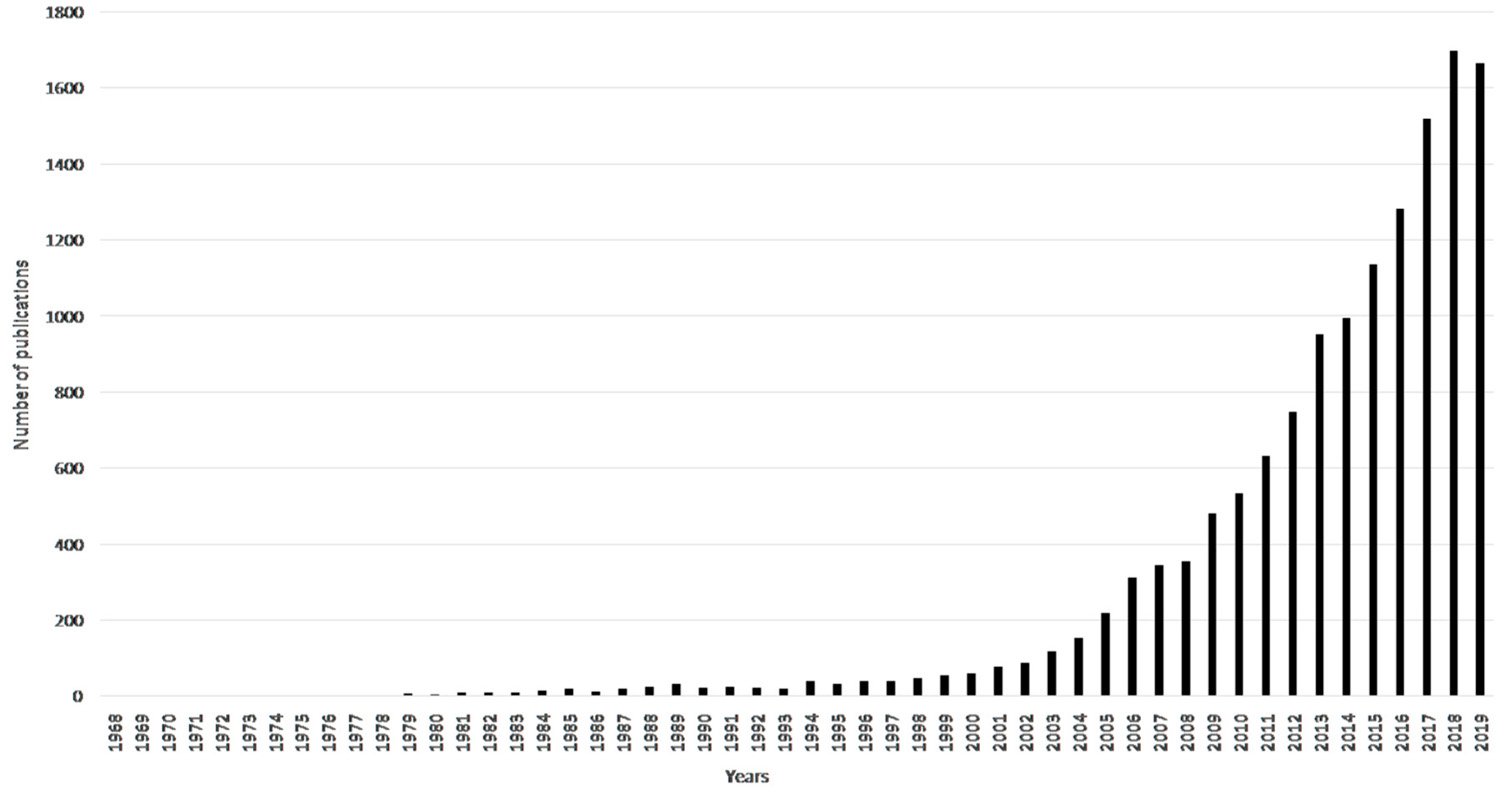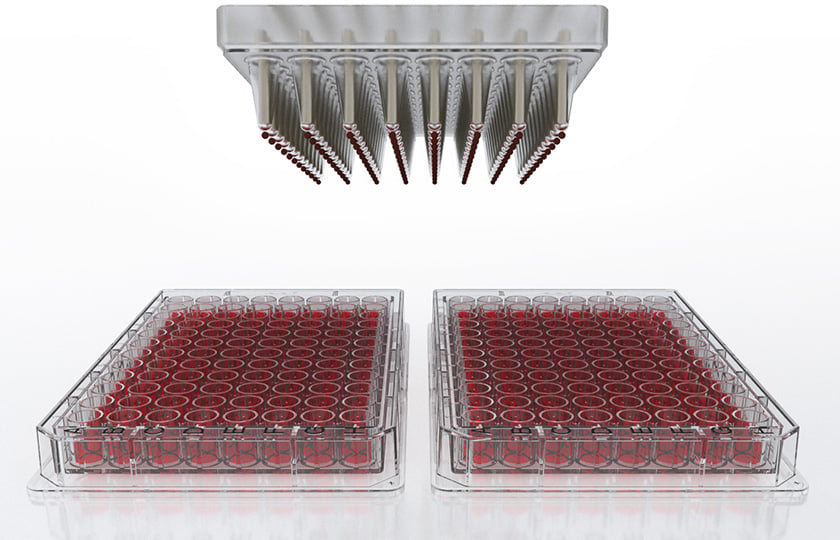3D Cell Cultures are Better than Animal Models - Here´s Why!
Animal models are costly, time-consuming, and often have limited relevance to human biology. Have you wondered if there are better alternatives?
Fortunately, there are powerful emerging substitutes for animal testing: three-dimensional (3D) cell cultures [1]. These are culture environments that allow cells to grow and interact with surrounding extracellular framework in three dimensions. A 3D cell culture is defined by a cell culture that can mimic a living organ’s organization and microarchitecture. [1]
The relevance and significant potential of 3D cell culture is certainly reflected in the exponential increase in the number of publications on the topic (Figure 1).

Figure 1: Number of publications about 3D cell culture on PubMed by each year since 1968[1]
3D cell cultures are highly valuable tools. To help you with the practical steps of growing and handling them, you can take advantage of techniques based on magnetism.
In this article, we’ll explain the advantages of magnetic 3D cell culture (M3D), why they are so useful, and how they are used in the laboratory – step-by-step.
3D models with human cells better reflect human physiology
Many simple animal models don't work that well because they are too far removed from human physiology. On the other hand, experiments with more sophisticated animals such as primates are very difficult to justify ethically. They are also very expensive, the requirements for their approval are high, and they are time-consuming to perform.
Cell culture allows for better control of variables, whereas in vivo, many variables are uncontrolled, and their effects are sometimes unknown due to the complexity of the organisms. Therefore, cell culture can improve reproducibility and facilitate the study of cellular and molecular mechanisms. Another major advantage of cell culture as an alternative to animal models is that human-based models can be grown using human cells, potentially minimizing the questionable translation of in vitro results to humans [1]. Thus, the similarity of 3D models to human physiology is far greater.
Magnetic 3D Cell Cultures are tools that enable a lower complexity in the handling of 3D cell culture
3D cell culture models come in different varieties, from spheres consisting of a single cell type to heterogeneous models such as tumor cells with fibroblasts or immune cells. Organoids are also 3D cells, including the micro-histology of the tissue, which adds additional complexity to the model. In a screening format, 3D cell-based assays are technically quite challenging to perform. The good news is that it is becoming easier to generate spheroids in microtiter plates for screening.
Watch our video on practical steps of performing 3D cell culture here.
Magnetic 3D cell culture (M3D) make your life in the lab easier with simpler workflows.
Harnessing the potential of 3D cell culture
To capture the complexity of 3D cell culture, Greiner Bio-One has developed the Multi-MagPen for M3D Cell Culture transfer – a smart assistant for rapid transfer of cells through a simple "pick-up-and-drop" step, available for 24-well and 96-well plates. With this method, M3D cell cultures can be transferred without pipetting or disrupting their tissue architecture [2, 3].
A full transfer of 3D cultures is accomplished through a simple "pick-up-and-drop" step that simplifies and speeds media changes, incubation steps, and co-culture creation. Magnetic 3D cell culture also enables straightforward immunohistochemical staining, blocking, and washing of 3D cell cultures.
We have created a video for you that shows you step-by-step how to perform 3D cell culture transfer. The process includes 8 steps. The system consists of the Multi-MagPen Drive, Multi-MagPen Sleeve, and Cell-Repellent plate.
Protocol for using Multi-MagPen magnetic 3D cell culture transfer:
- Prepare Cell-Repellent donor plate containing magnetized 3D cell culture.
- Insert Multi-MagPen Sleeve into the donor plate.
- Insert Multi-MagPen Drive into Multi-MagPen Sleeve and agitate briefly.
- Simply "pick-up-and-drop" for 3D cell culture transfer from donor plate to receiver plate.
- Remove the Multi-MagPen Drive from the Multi-MagPen Sleeve.
- Place the receiver plate on the Holding Drive to pull 3D cell cultures away from the Multi-MagPen Sleeve. The magnetic force of the Holding Drive keeps magnetized 3D cell cultures at the bottom of the well.
- Remove the Multi-MagPen Sleeve from the receiver plate.
- All cell cultures have been transferred simultaneously to the receiver plate. You also have the option of individual 3D cell culture transfer with Single-MagPen.
Ready to enter the next level?
Please fill out this form and contact our experts today to find the perfect solution for you!
Don't miss our regular updates on scientific topics around 3D Cell Culture
References
[1] Bédard, P., Gauvin, S., Ferland, K., Caneparo, C., Pellerin, È., Chabaud, S., & Bolduc, S. (2020). Innovative Human Three-Dimensional Tissue-Engineered Models as an Alternative to Animal Testing. Bioengineering (Basel, Switzerland), 7(3), 115. https://doi.org/10.3390/bioengineering7030115
[2] Haisler WL, Timm DM, Gage JA, Tseng H, Killian TC, Souza GR. Three-dimensional cell culturing by magnetic levitation. Nat Protoc. 2013 Oct;8(10):1940-9. https://doi.org/10.1038/nprot.2013.125. Epub 2013 Sep 12. PMID: 24030442.
[3] Tseng H, Balaoing LR, Grigoryan B, Raphael RM, Killian TC, Souza GR, Grande-Allen KJ. A three-dimensional co-culture model of the aortic valve using magnetic levitation. Acta Biomater. 2014 Jan;10(1):173-82. http://doi.org/10.1016/j.actbio.2013.09.003 Epub 2013 Sep 11. PMID: 24036238.
